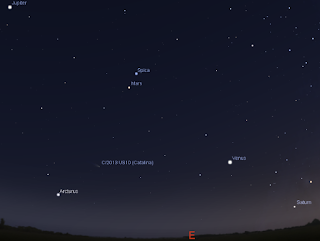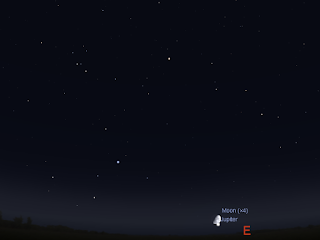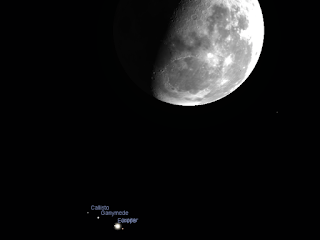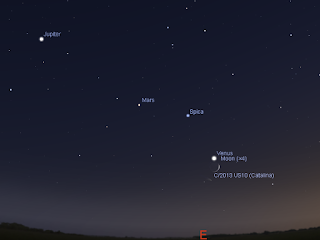A Rare Christmas Full Moon, and other Astronomical Treats of the Festive Season
- Written by The Conversation Contributor
While not much spectacular is going on in the Southern Hemisphere skies, Christmas day will see the first Christmas Full Moon for 38 years and Mars and bright star Spica close in the morning skies. Early morning sky on Friday December 25 looking east as seen from
Adelaide at 5:00 ACDST showing Jupiter, Mars, Venus and comet C/2013 US10. Similar views will be seen elsewhere in Australia at the equivalent local time. (click to embiggen).
Early morning sky on Friday December 25 looking east as seen from
Adelaide at 5:00 ACDST showing Jupiter, Mars, Venus and comet C/2013 US10. Similar views will be seen elsewhere in Australia at the equivalent local time. (click to embiggen).
If you are one of being Santa’s Helpers and are up in the early morning on the 25th around 5 am distributing presents and helping Santa eat all those biscuits, then you will see 4 bright planets, Jupiter, Mars, Venus (and if you have a level horizon) Saturn.
As an added bonus on Christmas morning Mars and the Bright star Spica are at their closest (strictly speaking, they were at their closest on Thursday, but what is a mere 0.01 arc minutes between friends.
 The Christmas Moon rises under the constellation of Orion, with Taurus, the Pleiades and Canis Major nearby. This shows the north-eastern horizon at around 10:00 pm local daylight saving time. (click to embiggen).
The Christmas Moon rises under the constellation of Orion, with Taurus, the Pleiades and Canis Major nearby. This shows the north-eastern horizon at around 10:00 pm local daylight saving time. (click to embiggen).
If the beautiful morning planets are not enough, the evening is rather special.
As you are contemplating your evening barbie and Christmas pud, the rising full moon is the first Christmas Full Moon since 1977, a gap of 38 years. The next will not be until 2034, 19 years later.
Put it another way, the last time we had a full Moon on Christmas, the first Star Wars movie “A new Hope” was playing in cinemas, this Christmas Full Moon sees “The Force Awakens”.
While this is a long time between Full Moons, there are much longer gaps. People had to wait 57 years from 1920 to 1977’s Christmas Full Moon.
And Christmas is not special, December 23 will see only 3 Full Moons between 1900 and 2100, with gaps of 19, 46 and 76 years between full Moons. September 3 and May 24 only saw 3 Full Moons too. Indeed, if you saw the Full Moon on May 24, 1956, you will have to wait 133 years until 2089 to see the next Full Moon on May 24.
Exactly why there are these long gaps, I do not know. As the time from Full Moon to Full Moon is 29.5 days, whereas the months are 30-31 days (Excepting February, which is 28, and 29 in leap years), the date of the full Moon will slowly drift over the course of the year.
Typically, it takes 19 years for a Full Moon to fall on the same date again, however, gaps can occur in multiples of 19 (133 is 7 x 19 and 114 is 6x 19), but I’m not sure why. There are also weird fractions of 19 (46 years is 2.42 x 19). Again, I have no idea why this is.
After Christmas, New Years holds a small celestial treat.
 On the morning of New Years Day, if you are up celebrating, you will see
Jupiter and the waning Moon rise shortly before (non-daylight saving) or shortly after (daylight saving) midnight.
On the morning of New Years Day, if you are up celebrating, you will see
Jupiter and the waning Moon rise shortly before (non-daylight saving) or shortly after (daylight saving) midnight.
If you have bought binoculars or a low powered telescope to the New Years celebration you can see both the Moon and Jupiter’s moons (along with Jupiter) in the binocular or telescope field of view on New Years morning.
Jupiter and the Moon will be at their closest a couple of hours after midnight, so if you have a long celebration it is well worth watching the pair during the proceedings.
 Telescopic view of the Moon and Jupiter, simulating the view through a 25 mm eyepiece on a 4" Newtonian Reflector at 2:30 pm daylight saving time.
Telescopic view of the Moon and Jupiter, simulating the view through a 25 mm eyepiece on a 4" Newtonian Reflector at 2:30 pm daylight saving time.
After New Years the Moon visits the rest of the planets.
On the mornings of January 4th Mars and crescent Moon are close, on the 7th, Venus Saturn and crescent Moon are close and on the morning of the 9th, Venus and Saturn spectacularly close (also visible together in a low power telescope).
 The line-up of Jupiter, crescent Moon, Mars and Venus as seen from
Adelaide on the morning of 7 December at 5:00 am. (click to embiggen)
The line-up of Jupiter, crescent Moon, Mars and Venus as seen from
Adelaide on the morning of 7 December at 5:00 am. (click to embiggen)
Authors: The Conversation Contributor





